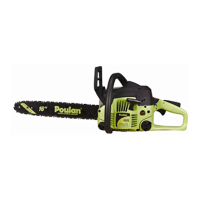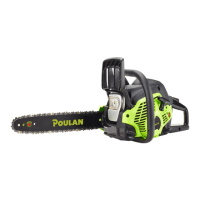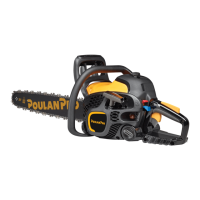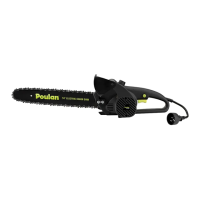KICKBACK
SAFETY
FEATURES
A wnnHtxC:
ire for
owrng
features
. :+: i
-
. : -' sa*
to
l^e
p
'educe
the
:: :- L'
.
:.:a:'
^:r'/ever
SUCh
features
'-.
. z
- -3:e
ln s danger.
As a
'
:
-
-:r,
-s€- ::^al
.eiyonlyonsafetyde
':-
--s:'olow
all safety
Precau-
-
-
!1':31'r-S
and
maintenance
In this
..
-1
'-
'e
c
avord
kickback and
other
:-
.r
-
:
^
: an
.esl,lt
in
senous
Inlirry.
.
:+:-,:e:-Krckback
Guide
Bar, designed
^:
a small
radius tip which
reduces the
s:s
Jf the
kickback danger
zone on the
:a'
tro. A Reduced-Kickback
Guide
Bar
^as
been demonstrated
lo significantly
re-
cuce the
number and seriousness
of
kick-
backs
when lesled
in
accordance
with
salety
requirements
for
gasoline
powered
chain saws
as set by
ANSI 81 75.1
.
Feduced
K ckback SVmmetrrcal Gurde
Bar
Syrrlrrrclr ca Cu.ie
Bar
Larqe
Radlus T
P
Low
Kickback Chain, designed
with a
contoured
depth
gauge
and
guard
link
which deflect
klckback lorce and allow
wood to
gradually ride intothe cutter. Low-
Kickback Charn
has met kickback
per
formance
requrrements when tested
on a
representative sample of chain saws
be-
low 3.8 cubrc
inch displacement specified
in ANS| B
1 75.1 .
r
D
nlr'4..o'
pr[-ll
1-qdrp,),,...,.dt,,t
',
\*---=
-
tl I
\t
I
Lrrt
ect\
I
k
okbnck
{orce
Low
^K,c[baL]h \
ancl al ows
woori
(,Ila
rl
lo
qrn(iua y
lClC
rnto alrilef
\\
Can Obslnrct
l\"4:rlef a
Nol a Low.- Krckback Clra
I
.
Front Hand
Guard,
designed to reduce
the
chance of
your
lefi hand
contacting
the charn
rf
vour
hand sllDs off the
front handlebar.
.
Position of
front
and
rear lmndlebars. de-
sroned with distance between
handles and
'rn-lrne
with each other.
The spread and
"in
line
position
of the hands
provided
by
thrs
design work together
to
give
balance and
re
sistance
In
controlling
the
pivot
of the saw
back toward
the
operator
if kickback occurs.
CHAIN
BRAKE
AND
CKA
ANGLE
.
Chain
Brake, designed to stop
the
chain
in
the event of
kickback.
Awanlttllc: wE Do
Nor REP,
RESENT AND
YOU
SHOULD
NOT
AS-
SUN4E
THAT
THE
CHAIN
BRAKE
WILL
PROTECT YOU IN THE EVENT OF
A
KICK-
BACK
Krckback
is
a
lightning fast aclton
whrch throws the bar and
rotatang chain
back
and up
toward the operator.
Kickback can be
caused bv allowrng
contact of the bar
tip in the
danger
zone
w(h
any
hard
object.
Kickback
can also
b€ caused by
prnchrng
the saw chaln
along
the top of the
guide
bar.
This action
may
push
the
gulde
bar
rapidly
back
toward the op-
erator.
Efiher of these events
may cause
you
to lose control of
the
saw
whrch could
result in
serious
inrurv or even death.
DO NOT
RELY
UPON
ANY
OF
THE DEVICES BUILT
INTO
YOUR
SAW
YOU SHOULD USE
THE SAW
PROPERLY
AND
CAREFULLY
TO
AVOID
KICKBACK.
Reduced-kickback
guide
bars
and
low-kickback saw chains
reduce the
chance
and
magnrtude
o{
kickback and are
recommended.
Your saw has a low
kickback
chain
and bar as original equipment.
Repairs
on a chain
brake should be
made
by
an autho
rized
servicing
dealer.
Take
your
unit lo
the
olace
of
ourchase
if
ourchased
from a servic
ing
dealer,
or to the
nearest
aulhorized
master
servrce oearer.
.
llp contact
in
some
cases may cause a
light
ning fast reverse REACTION,
kicking
guide
bar uo and back
toward
ooeralor.
.
Pinching
the saw chain along the
lop of the
guide
bar may
push
the
guide
bar rapidly
back
toward the operator.
.
Either of
these reactions mav cause
vou
to
lose control ol
lhe
saw
whicii could
result rn
serious
injury. Do
not rely
exclusively
upon
devices
built
into
your
saw.
A
wnnrutruc: compuled
kickback
angle
(CKA)
listed on
your
saw and
lisled in the
CKA
table below represenls angle of
kickback
your
bar and chain combinations
will
have
when tesled
in
accordance
with CSA
(Cana-
dian Standards
Association) and
ANSI stan-
dards.
When
purchasing
replacement bar
and
chain. considerations should
be
given
to the
lower CKA values.
Lower
CKA
values
repre
senl safer
angles to the user,
higher values
in
dicate
more angle and higher kick energies.
Computed
angles
represented indicate total
energy
and angle associated
without activation
o{
the chain brake during
kickback. Activated
angle
represents chain stopping tame
relative to
actvation
angle of chain break and
resulting
kick angle ol saw.
In
all
cases lower CKA
val
ues represent a sa{er operating
environment
for the user.
The following
guide
bar
and chain combina
tions meel
kickback requrrements of CSA
Standards
262]
,
262.3, &
ANSI 8175.'1
when used on saws
listed in this manual.
Use of bar and
chain combinations other
than those
listed is not
recommended and
may not meet the CKA
requirements
per
standard.
**
\-o

